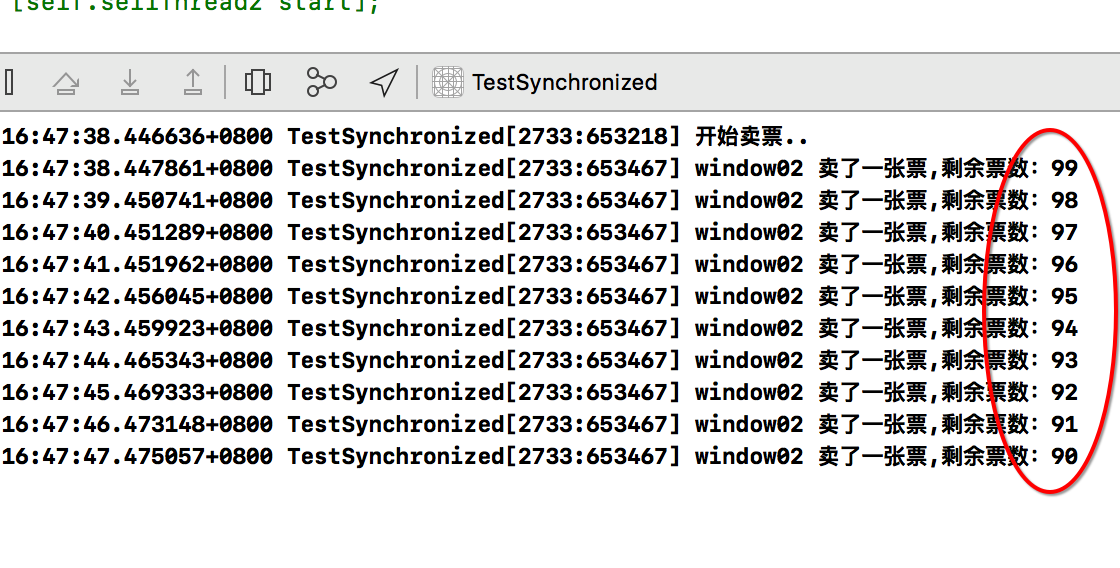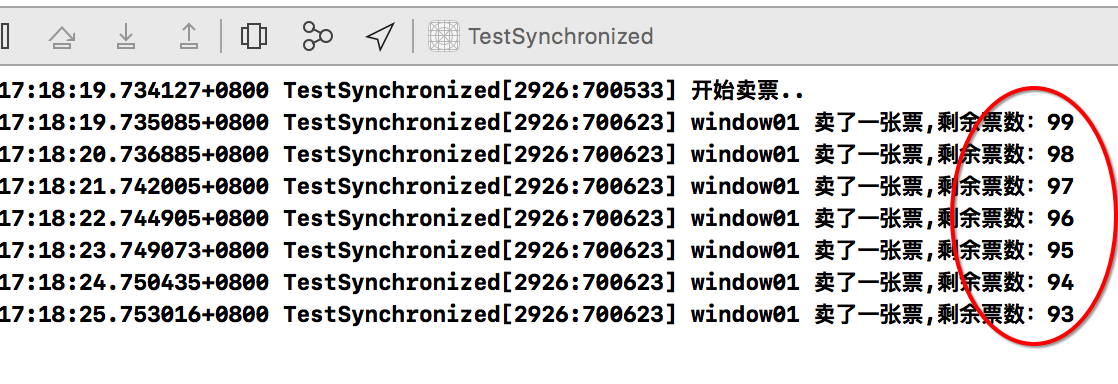多线程中的资源同步
2017-05-12
关于资源同步
所谓的资源同步就是在多个线程中,共享同一资源,由于每个线程都对这一公共的资源都有操作,所以有可能回发生:A线程正在利用资源r做操作时,而资源r却在此时被线程B所修改了。这就有可能会引起一系列的问题。所以资源同步就是指:当线程A利用资源r的时候,不允许其它线程访问资源r,这就是多线程中的资源同步。
- 在单线程中,资源一定是同步的
- 只有多线程中的共享资源(公共资源)才需要资源同步
资源同步发生的场景
在平常的编码中,当我们声明某一个变量时,我们首先要想到这个变量的使用场景:即是不是在多线程环境下,该变量(资源)是不是在不同的线程中都被操作(包括读取和修改),如果存在,那么就需要对这个资源做线程同步。
OC中的资源同步
OC中的资源同步有多种方式,下面我具体罗列出来:
- 用@synchronized 关键字
- 使用NSLock 加锁的方式(锁一定要成对出现,不然的话就会发生死锁)
- 把对共有资源的操作放到同一个串行队列中
资源同步问题场景
用多线程来模拟一个买票的程序,如果不加资源同步的话,买票的结果就是乱七八糟的,100张票有可能被卖了150次。在这里:
- 票的总张数是一定的
- 一个线程代表一个买票窗口
实现以上场景:
@interface ViewController ()
@property (nonatomic,assign) int ticketsCounts; // 票总张数
@property (nonatomic,strong) NSThread *sellThread1; // 卖票线程1
@property (nonatomic,strong) NSThread *sellThread2; // 卖票线程2
@property (nonatomic,strong) NSLock *ticketsLock;
@end
@implementation ViewController
- (void)viewDidLoad {
[super viewDidLoad];
// Do any additional setup after loading the view, typically from a nib.
self.ticketsCounts = 100;
self.sellThread1 = [[NSThread alloc] initWithTarget:self selector:@selector(sellWindow01_NotThreadSelf) object:nil];
self.sellThread2 = [[NSThread alloc] initWithTarget:self selector:@selector(sellWindow02_NotThreadSelf) object:nil];
NSLog(@"开始卖票..");
[self.sellThread1 start];
[self.sellThread2 start];
self.ticketsLock = [[NSLock alloc] init];
}
- (void)sellWindow01_NotThreadSelf
{
while (self.ticketsCounts) {
if (self.ticketsCounts == 0) {
[self.sellThread1 cancel];
NSLog(@"window01: 票卖完了... ");
return;
}
self.ticketsCounts -= 1;
NSLog(@"window01 卖了一张票,剩余票数:%d ",self.ticketsCounts);
usleep(1000*1000); // 休眠1s
}
}
- (void)sellWindow02_NotThreadSelf
{
while (self.ticketsCounts) {
if (self.ticketsCounts == 0) {
[self.sellThread1 cancel];
NSLog(@"window02: 票卖完了... ");
return;
}
self.ticketsCounts -= 1;
NSLog(@"window02 卖了一张票,剩余票数:%d ",self.ticketsCounts);
usleep(1000*1000); // 休眠1s
}
}
/*
触摸屏幕停止卖票
*/
- (void)touchesBegan:(NSSet<UITouch *> *)touches withEvent:(UIEvent *)event
{
[self.sellThread1 cancel];
[self.sellThread2 cancel];
NSLog(@"停止买票,现在剩余票数=%d",self.ticketsCounts);
}
- (void)didReceiveMemoryWarning {
[super didReceiveMemoryWarning];
// Dispose of any resources that can be recreated.
}
我们看一下运行结果,很显然-剩余票数是混乱的。

解决资源不同步问题
我们这里只介绍在OC语言中资源同步的方法。
@synchronized
直接在卖票操作时,使用@synchronized关键字同步资源。
- (void)viewDidLoad {
[super viewDidLoad];
// Do any additional setup after loading the view, typically from a nib.
self.ticketsCounts = 100;
self.sellThread1 = [[NSThread alloc] initWithTarget:self selector:@selector(sellWindow01) object:nil];
self.sellThread2 = [[NSThread alloc] initWithTarget:self selector:@selector(sellWindow02) object:nil];
NSLog(@"开始卖票..");
[self.sellThread1 start];
[self.sellThread2 start];
self.ticketsLock = [[NSLock alloc] init];
}
- (void)sellWindow01
{
/* 同步代码块 */
@synchronized (self) {
while (self.ticketsCounts) {
if (self.ticketsCounts == 0) {
[self.sellThread1 cancel];
NSLog(@"window01: 票卖完了... ");
return;
}
self.ticketsCounts -= 1;
NSLog(@"window01 卖了一张票,剩余票数:%d ",self.ticketsCounts);
usleep(1000*1000); // 休眠1s
}
}
}
- (void)sellWindow02
{
/** 同步代码块 **/
@synchronized (self) {
while (self.ticketsCounts) {
if (self.ticketsCounts == 0) {
[self.sellThread2 cancel];
NSLog(@"window02: 票卖完了... ");
return;
}
self.ticketsCounts -= 1;
NSLog(@"window02 卖了一张票,剩余票数:%d ",self.ticketsCounts);
usleep(1000*1000); // 休眠1s
}
}
}
我们可以看到,此时资源就同步了。

NSLock
OC为我们提供了NSLoc,我们可以在对引发资源不同步的操作加上锁,这样也可以保证资源同步。
- (void)sellWindow01
{
/** 加锁 **/
[self.ticketsLock lock];
while (self.ticketsCounts) {
if (self.ticketsCounts == 0) {
[self.sellThread1 cancel];
NSLog(@"window01: 票卖完了... ");
return;
}
self.ticketsCounts -= 1;
NSLog(@"window01 卖了一张票,剩余票数:%d ",self.ticketsCounts);
usleep(1000*1000); // 休眠1s
}
[self.ticketsLock unlock];
}
- (void)sellWindow02
{
/** 加锁 **/
[self.ticketsLock lock];
while (self.ticketsCounts) {
if (self.ticketsCounts == 0) {
[self.sellThread2 cancel];
NSLog(@"window02: 票卖完了... ");
return;
}
self.ticketsCounts -= 1;
NSLog(@"window02 卖了一张票,剩余票数:%d ",self.ticketsCounts);
usleep(1000*1000); // 休眠1s
}
[self.ticketsLock unlock];
}
利用宏定义,来简化加锁操作并带有日志:
#define TVULOCK(weblock)\
do{\
[weblock lock];\
NSLog(@"%s----lock-----%d",__func__,__LINE__);\
}while(0)
#define TVUUNLOCK(weblock)\
do{\
[weblock unlock];\
NSLog(@"%s----unlock-----%d",__func__,__LINE__);\
}while(0)
运行结果如图所示:

利用GCD串行队列
使用GCD串行队列也可以做资源同步。具体做法是:
- 创建一个串行队列
- 把公共代码放到串行队列中去执行
@property (nonatomic,strong) dispatch_queue_t phoneQueue;
- (dispatch_queue_t)phoneQueue
{
if (!_phoneQueue) {
_phoneQueue = dispatch_queue_create("phone_queue", DISPATCH_QUEUE_SERIAL);
}
return _phoneQueue;
}
- (void)sellWindow01
{
/** 放入串行队列中 **/
dispatch_async(self.phoneQueue, ^{
while (self.ticketsCounts) {
if (self.ticketsCounts == 0) {
[self.sellThread1 cancel];
NSLog(@"window01: 票卖完了... ");
return;
}
self.ticketsCounts -= 1;
NSLog(@"window01 卖了一张票,剩余票数:%d ",self.ticketsCounts);
usleep(1000*1000); // 休眠1s
}
});
}
- (void)sellWindow02
{
/** 放入串行队列中 **/
dispatch_async(self.phoneQueue, ^{
while (self.ticketsCounts) {
if (self.ticketsCounts == 0) {
[self.sellThread2 cancel];
NSLog(@"window02: 票卖完了... ");
return;
}
self.ticketsCounts -= 1;
NSLog(@"window02 卖了一张票,剩余票数:%d ",self.ticketsCounts);
usleep(1000*1000); // 休眠1s
}
});
}
运行结果如图所示:

